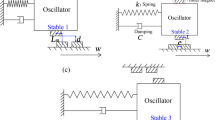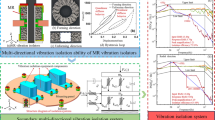Abstract
The wind-induced vibration of a remote sensing tower is the key factor affecting the stability of image sensing and structural reliability. Monitoring the vibration of a long-time unattended tower is critical to its proper operation. Currently, most monitoring devices are supplied with wired power or battery, significantly limiting their practical applications in remote areas. In this paper, a self-powered vibration sensing device based on hybrid electromechanical conversion mechanisms is proposed. The device depends on a cylindrical magnetic levitation structure sensitive to ambient vibration for transferring mechanical energy and takes as a dual-functional heterogeneous integrated system comprising electromagnetic, piezoelectric, and triboelectric generators. When the device vibrates under environmental force driving, the suspension magnet reciprocates vertically and generates induced electromagnetic energy, which is used to power the device. Moreover, the triboelectric and piezoelectric voltages, respectively originating from magnet impact on two separation friction materials and magnetic field repulsion-induced strain deformation of a piezoelectric sheet, are used as the synergistic sensing signals. To improve the output energy, a set of dual-segmented annular coils is designed in an electromagnetic generator, which greatly avoids the obstructive effect of the suspended magnet on the magnetic flux change at its end. Compared with a whole isochoric coil, it increases the output voltage by 78.3%. For the triboelectric sensing module, a silicone film with a large specific surface area is fabricated via 3D modification, which improves the output voltage by 29.4%. Furthermore, a pair of piezoelectric sensing modules is set to improve the accuracy of comparative sensing data. The experimental measurement shows that the device maintains a high sensitivity of 6.711 V (m s−2)−1 and excellent linearity of 0.991 in the range of 0–14 m s−2. This work provides a practical strategy for the vibration monitoring of remote sensing tower and exhibits attractive potential in early warning and data analysis.
Similar content being viewed by others
References
Song R, Muller J P, Kharbouche S, et al. Validation of space-based albedo products from upscaled tower-based measurements over heterogeneous and homogeneous landscapes. Remote Sens, 2020, 12: 833
Cheng X, Zhou Y, Hu M, et al. The links between canopy solar-induced chlorophyll fluorescence and gross primary production responses to meteorological factors in the growing season in deciduous broadleaf forest. Remote Sens, 2021, 13: 2363
Roy A, Toose P, Mavrovic A, et al. L-band response to freeze/thaw in a boreal forest stand from ground- and tower-based radiometer observations. Remote Sens Environ, 2020, 237: 111542
Marrs J K, Jones T S, Allen D W, et al. Instrumentation sensitivities for tower-based solar-induced fluorescence measurements. Remote Sens Environ, 2021, 259: 112413
Sun C, Beirne C, Burgar J M, et al. Simultaneous monitoring of vegetation dynamics and wildlife activity with camera traps to assess habitat change. Remote Sens Ecol Conservat, 2021, 7: 666–684
Liu F, Wang X, Wang C. Measuring vegetation phenology with near-surface remote sensing in a temperate deciduous forest: Effects of sensor type and deployment. Remote Sens, 2019, 11: 1063
Wang Z L, Zhuang X X, Zhang L Q. Effect of image motion and vibration on image quality of TDICCD camera. Appl Mech Mater, 2012, 128–129: 584–588
Nico G, Prezioso G, Masci O, et al. Dynamic modal identification of telecommunication towers using ground based radar interferometry. Remote Sens, 2020, 12: 1211
Matikainen L, Lehtomäki M, Ahokas E, et al. Remote sensing methods for power line corridor surveys. ISPRS J Photogram Remote Sens, 2016, 119: 10–31
Zhao L, Huang X, Jia J, et al. Detection of broken strands of transmission line conductors using fiber Bragg grating sensors. Sensors, 2018, 18: 2397
Quan W, Li X, Liu J, et al. Genetic algorithm for accurate modeling of distributed Bragg reflector laser power and wavelength. Opt Eng, 2019, 58: 1–20
Hosseinkhani A, Younesian D, Eghbali P, et al. Sound and vibration energy harvesting for railway applications: A review on linear and nonlinear techniques. Energy Rep, 2021, 7: 852–874
Wei X, Zhao Z, Zhang C, et al. All-weather droplet-based triboelectric nanogenerator for wave energy harvesting. ACS Nano, 2021, 15: 13200–13208
Zhang X S, Han M, Kim B, et al. All-in-one self-powered flexible microsystems based on triboelectric nanogenerators. Nano Energy, 2018, 47: 410–426
Zhang C, Liu Y, Zhang B, et al. Harvesting wind energy by a triboelectric nanogenerator for an intelligent high-speed train system. ACS Energy Lett, 2021, 6: 1490–1499
Fan F R, Tian Z Q, Wang Z L. Flexible triboelectric generator. Nano Energy, 2012, 1: 328–334
Zhu G, Lin Z H, **g Q, et al. Toward large-scale energy harvesting by a nanoparticle-enhanced triboelectric nanogenerator. Nano Lett, 2013, 13: 847–853
Wen D L, Huang P, Qian H Y, et al. Hybrid nanogenerator-based self-powered double-authentication microsystem for smart identification. Nano Energy, 2021, 86: 106100
Maharjan P, Bhatta T, Salauddin M, et al. A human skin-inspired self-powered flex sensor with thermally embossed microstructured triboelectric layers for sign language interpretation. Nano Energy, 2020, 76: 105071
Hou X J, Zhang S N, Yu J B, et al. Monolithic homogeneous integrated miniaturized triboelectric nanogenerator with an inner air cavity for energy harvesting. Sci China Tech Sci, 2021, 64: 662–672
Meng Z, Chen L. Theoretical maximum efficiency and higher power output in triboelectric nanogenerators. Energy Rep, 2020, 6: 2463–2475
Zou Y, Xu J, Chen K, et al. Advances in nanostructures for highperformance triboelectric nanogenerators. Adv Mater Technologies, 2021, 6: 2000916
Xu G P, Zheng Y B, Feng Y G, et al. A triboelectric/electromagnetic hybrid generator for efficient wind energy collection and power supply for electronic devices. Sci China Tech Sci, 2021, 64: 2003–2011
Chen Y L, Liu D, Wang S, et al. Self-powered smart active RFID tag integrated with wearable hybrid nanogenerator. Nano Energy, 2019, 64: 103911
Shao J J, Jiang T, Wang Z L. Theoretical foundations of triboelectric nanogenerators (TENGs). Sci China Tech Sci, 2020, 63: 1087–1109
Zhang Z X, He J, Han J Q, et al. Magnetically levitated/piezoelectric/triboelectric hybrid generator as a power supply for the temperature sensor. Sci China Tech Sci, 2017, 60: 1068–1074
Wang Z, Yu Y, Wang Y, et al. Magnetic flap-type difunctional sensor for detecting pneumatic flow and liquid level based on triboelectric nanogenerator. ACS Nano, 2020, 14: 5981–5987
Liang X, Jiang T, Liu G, et al. Spherical triboelectric nanogenerator integrated with power management module for harvesting multidirectional water wave energy. Energy Environ Sci, 2020, 13: 277–285
Jiang T, Pang H, An J, et al. Robust swing-structured triboelectric nanogenerator for efficient blue energy harvesting. Adv Energy Mater, 2020, 10: 2000064
Deka B K, Hazarika A, Lee S, et al. Triboelectric-nanogenerator-integrated structural supercapacitor based on highly active P-doped branched Cu-Mn selenide nanowires for efficient energy harvesting and storage. Nano Energy, 2020, 73: 104754
**e Z, Dong J, Yang F, et al. Sweep-type triboelectric linear motion sensor with staggered electrode. Extreme Mech Lett, 2020, 37: 100713
Zhu J, Zhu M, Shi Q, et al. Progress in TENG technology—A journey from energy harvesting to nanoenergy and nanosystem. EcoMat, 2020, 2: e12058
Wang J, Wu Z, Pan L, et al. Direct-current rotary-tubular triboelectric nanogenerators based on liquid-dielectrics contact for sustainable energy harvesting and chemical composition analysis. ACS Nano, 2019, 13: 2587–2598
Mu J, He H, Song J, et al. Functional structure enhanced synergistic sensing from triboelectric-electromagnetic hybrid nanogenerator for self-powered rotating speed monitoring. Energy Rep, 2022, 8: 5272–5283
Bai P, Zhu G, **g Q, et al. Membrane-based self-powered triboelectric sensors for pressure change detection and its uses in security surveillance and healthcare monitoring. Adv Funct Mater, 2014, 24: 5807–5813
Lee K Y, Yoon H, Jiang T, et al. Fully packaged self-powered triboelectric pressure sensor using hemispheres-array. Adv Energy Mater, 2016, 6: 1502566
Lai S N, Chang C K, Yang C S, et al. Ultrasensitivity of self-powered wireless triboelectric vibration sensor for operating in underwater environment based on surface functionalization of rice husks. Nano Energy, 2019, 60: 715–723
**ang C, Liu C, Hao C, et al. A self-powered acceleration sensor with flexible materials based on triboelectric effect. Nano Energy, 2017, 31: 469–477
Liu C, Fang L, Zou H, et al. Theoretical investigation and experimental verification of the self-powered acceleration sensor based on triboelectric nanogenerators (TENGs). Extreme Mech Lett, 2021, 42: 101021
Zhang H, Yang Y, Su Y, et al. Triboelectric nanogenerator for harvesting vibration energy in full space and as self-powered acceleration sensor. Adv Funct Mater, 2014, 24: 1401–1407
Dai K, Wang X, Yi F, et al. Triboelectric nanogenerators as self-powered acceleration sensor under high-g impact. Nano Energy, 2018, 45: 84–93
Zhang B, Zhang L, Deng W, et al. Self-powered acceleration sensor based on liquid metal triboelectric nanogenerator for vibration monitoring. ACS Nano, 2017, 11: 7440–7446
Yu H, He X, Ding W, et al. A self-powered dynamic displacement monitoring system based on triboelectric accelerometer. Adv Energy Mater, 2017, 7: 1700565
Chen Y, Wang Y C, Zhang Y, et al. Elastic-beam triboelectric nano-generator for high-performance multifunctional applications: sensitive scale, acceleration/force/vibration sensor, and intelligent keyboard. Adv Energy Mater, 2018, 8: 1802159
Wu Z, Ding W, Dai Y, et al. Self-powered multifunctional motion sensor enabled by magnetic-regulated triboelectric nanogenerator. ACS Nano, 2018, 12: 5726–5733
Qu Z, Wu L, Yue B, et al. Eccentric triboelectric nanosensor for monitoring mechanical movements. Nano Energy, 2019, 62: 348–354
Liu C, Wang Y, Zhang N, et al. A self-powered and high sensitivity acceleration sensor with V-Q-a model based on triboelectric nanogenerators (TENGs). Nano Energy, 2020, 67: 104228
Du T, Zuo X, Dong F, et al. A self-powered and highly accurate vibration sensor based on bouncing-ball triboelectric nanogenerator for intelligent ship machinery monitoring. Micromachines, 2021, 12: 218
Author information
Authors and Affiliations
Corresponding authors
Additional information
Supporting Information
The supporting information is available online at tech.scichina.com and springer.longhoe.net. The supporting materials are published as submitted, without typesetting or editing. The responsibility for scientific accuracy and content remains entirely with the authors.
This work was supported by the National Natural Science Foundation of China (Grant Nos. 62101513, 51975542), the Natural Science Foundation of Shanxi Province (Grant No. 201901D111146), and Shanxi “1331 Project” Key Subject Construction (Grant No. 1331KSC).
Electronic supplementary material
11431_2022_2085_MOESM1_ESM.doc
Electro-mechanical coupling properties of self-powered vibration sensing device for near-surface observations tower monitoring, approximately 3.67 MB.
Rights and permissions
About this article
Cite this article
Mu, J., He, H., Mu, J. et al. Electromechanical coupling properties of a self-powered vibration sensing device for near-surface observation tower monitoring. Sci. China Technol. Sci. 65, 1545–1557 (2022). https://doi.org/10.1007/s11431-022-2085-4
Received:
Accepted:
Published:
Issue Date:
DOI: https://doi.org/10.1007/s11431-022-2085-4




